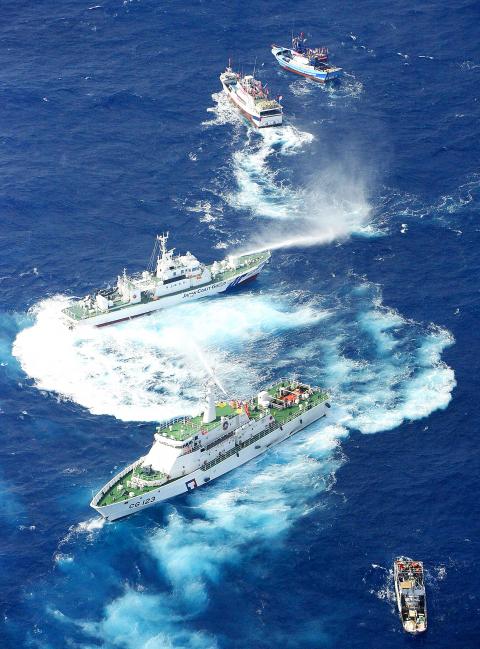Coast guard vessels from Taiwan and Japan dueled with water cannons yesterday as Taiwanese fishing boats sailed close to the disputed Diaoyutai Islands (釣魚台) to assert Taiwanese sovereignty over the islets.
The fishing boats came as close as 3 nautical miles (5.5km) to the Diaoyutais, known as the Senkakus in Japan, but were thwarted from making a possible landing by Japanese coast guard vessels, which deterred the protesters from approaching any further.
The Taiwanese boats arrived near the Diaoyutais at about 5am yesterday after sailing overnight escorted by 10 Coast Guard Administration (CGA) ships.

Photo: Kyodo / Reuters
The fishing boats assembled 18 nautical miles off the Diaoyutais to prepare for their planned circumnavigation of the island group in pods of five ships each. Their approach led to a standoff between the Taiwanese coast guard ships and their Japanese counterparts.
More than 10 Japanese patrol boats used flashlights and water cannons to disperse the Taiwanese fishing vessels, warning them over loudspeakers to leave. At one point, they also dropped smaller boats into the water and tried ramming them into the fishing boats.
CGA ships responded by firing water cannons and using loudspeakers and LED lights to say, in Chinese, “This is Taiwan’s territorial waters. You should not interfere with the operations of our fishermen.”
CGA ships sailed between the Taiwanese fishing vessels and Japanese patrol boats, at one point stopping in front of the Japanese boats to allow the fishing vessels room to maneuver.
Lin Jih-cheng (林日成), commander of an organizing committee on safeguarding fishing rights, said the ships were able to sail near the Diaoyutais and achieved the aim of their protest.
Considering the rough sea conditions, Lin announced at 9am that “the mission is completed, and all fishing boats will return to Nanfangao.”
CGA vessels remained about 4 nautical miles from the Diaoyutais to see that all fishing boats left the area safely.
The 75 Taiwanese fishing vessels, carrying banners reading “Defend our territorial waters” and “Diaoyutais are ours,” set off from the fishing port of Nanfangao (南方澳) in Yilan County on Monday to protest Japan’s recent move to nationalize the islands by buying three of them from a private owner.
The Diaoyutais, about 120 nautical miles northeast of Taipei, are administered by Japan, but claimed by Taiwan and China, and the fishermen wanted to assert Taiwanese sovereignty over the islands and their right to operate in what they call their traditional fishing grounds.
The CGA said its main goal was to prevent Japanese ships from boarding Taiwanese fishing boats or taking Taiwanese fishermen into custody.
CGA Deputy Director-General Wang Chung-yi (王崇儀) said the agency had simulated possible scenarios beforehand for the encounter and expected Japan to send large ships to the site.
“Japan mobilized 21 ships, with the largest weighing 6,000 tonnes,” Wang said.
He said that because of the rough sea conditions around the Diaoyutais, with waves as high as 4m, the CGA did not take more aggressive action, out of consideration for the fishing vessels.
He also said the coast guard did not encounter Chinese fishing boats during its escort mission, but noted that there were five Chinese patrol ships around the island chain, all outside the 12 nautical mile territorial zone.
The Ministry of National Defense said the navy dispatched one Cheng Kung and two Chi Yang-class frigates in waters off the coast of northeastern Taiwan in support of the Taiwanese fishing boats. Several sorties of F-16 and Mirage 2000 fighters also monitored the situation while conducting routine reconnaissance missions.
The island chain has been a traditional fishing ground of Taiwanese fishermen for several decades, but they have been harassed and chased away by Japanese coast guard ships in recent years.
Taiwan and Japan have held 16 rounds of fisheries talks to try to solve the dispute, to no avail.

FAST RELEASE: The council lauded the developer for completing model testing in only four days and releasing a commercial version for use by academia and industry The National Science and Technology Council (NSTC) yesterday released the latest artificial intelligence (AI) language model in traditional Chinese embedded with Taiwanese cultural values. The council launched the Trustworthy AI Dialogue Engine (TAIDE) program in April last year to develop and train traditional Chinese-language models based on LLaMA, the open-source AI language model released by Meta. The program aims to tackle the information bias that is often present in international large-scale language models and take Taiwanese culture and values into consideration, it said. Llama 3-TAIDE-LX-8B-Chat-Alpha1, released yesterday, is the latest large language model in traditional Chinese. It was trained based on Meta’s Llama-3-8B

STUMPED: KMT and TPP lawmakers approved a resolution to suspend the rate hike, which the government said was unavoidable in view of rising global energy costs The Ministry of Economic Affairs yesterday said it has a mandate to raise electricity prices as planned after the legislature passed a non-binding resolution along partisan lines to freeze rates. Chinese Nationalist Party (KMT) lawmakers proposed the resolution to suspend the price hike, which passed by a 59-50 vote. The Taiwan People’s Party (TPP) voted with the KMT. Legislative Speaker Han Kuo-yu (韓國瑜) of the KMT said the resolution is a mandate for the “immediate suspension of electricity price hikes” and for the Executive Yuan to review its energy policy and propose supplementary measures. A government-organized electricity price evaluation board in March

NO-LIMITS PARTNERSHIP: ‘The bottom line’ is that if the US were to have a conflict with China or Russia it would likely open up a second front with the other, a US senator said Beijing and Moscow could cooperate in a conflict over Taiwan, the top US intelligence chief told the US Senate this week. “We see China and Russia, for the first time, exercising together in relation to Taiwan and recognizing that this is a place where China definitely wants Russia to be working with them, and we see no reason why they wouldn’t,” US Director of National Intelligence Avril Haines told a US Senate Committee on Armed Services hearing on Thursday. US Senator Mike Rounds asked Haines about such a potential scenario. He also asked US Defense Intelligence Agency Director Lieutenant General Jeffrey Kruse

NOVEL METHODS: The PLA has adopted new approaches and recently conducted three combat readiness drills at night which included aircraft and ships, an official said Taiwan is monitoring China’s People’s Liberation Army (PLA) exercises for changes in their size or pattern as the nation prepares for president-elect William Lai’s (賴清德) inauguration on May 20, National Security Bureau (NSB) Director-General Tsai Ming-yen (蔡明彥) said yesterday. Tsai made the comment at a meeting of the Legislative Yuan’s Foreign Affairs and National Defense Committee, in response to Democratic Progressive Party (DPP) Legislator Wang Ting-yu’s (王定宇) questions. China continues to employ a carrot-and-stick approach, in which it applies pressure with “gray zone” tactics, while attempting to entice Taiwanese with perks, Tsai said. These actions aim to help Beijing look like it has